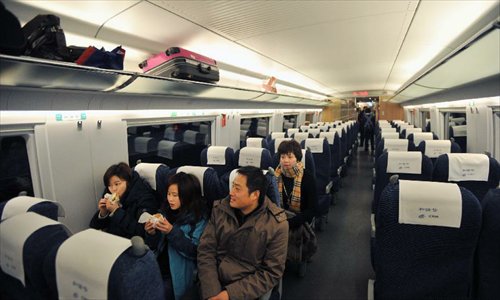
Passengers sit in high-speed train G502 at the Changsha South Railway Station in Changsha, capital of Central China's Hunan Province, December 26, 2012. The Changsha South Railway Station is one of the stops of the 2,298-kilometer Beijing-Guangzhou High-speed Railway, the world's longest, which was put into operation on Wednesday. Running at an average speed of 300 kilometers per hour, the high-speed railway will cut the travel time to about 8 hours from the current 20-odd hours by traditional lines between the country's capital and capital of South China's Guangdong Province. Photo: Xinhua
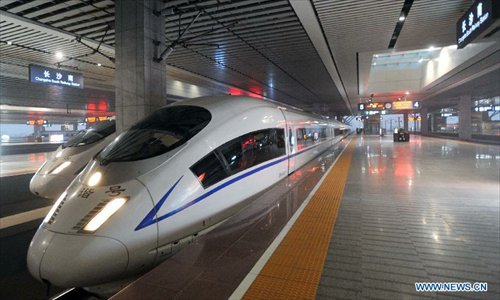
High-speed train G502 leaves the Changsha South Railway Station in Changsha, capital of Central China's Hunan Province, December 26, 2012. The Changsha South Railway Station is one of the stops of the 2,298-kilometer Beijing-Guangzhou High-speed Railway, the world's longest, which was put into operation on Wednesday. Running at an average speed of 300 kilometers per hour, the high-speed railway will cut the travel time to about 8 hours from the current 20-odd hours by traditional lines between the country's capital and capital of South China's Guangdong Province. Photo: Xinhua
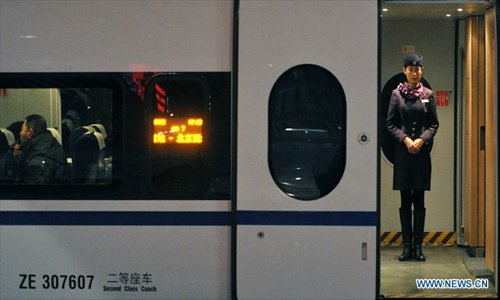
A stewardess wait to serve passengers in high-speed train G502 at the Changsha South Railway Station in Changsha, capital of Central China's Hunan Province, December 26, 2012. The Changsha South Railway Station is one of the stops of the 2,298-kilometer Beijing-Guangzhou High-speed Railway, the world's longest, which was put into operation on Wednesday. Running at an average speed of 300 kilometers per hour, the high-speed railway will cut the travel time to about 8 hours from the current 20-odd hours by traditional lines between the country's capital and capital of South China's Guangdong Province. Photo: Xinhua
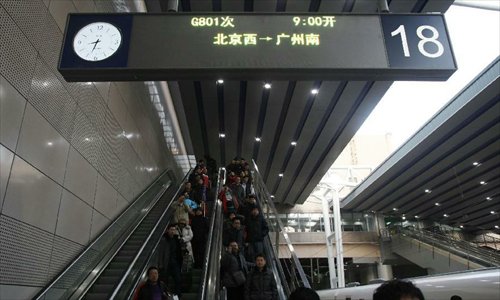
Passengers prepare to board bullet train G801 to leave for Guangzhou, capital of South China's Guangdong Province, at the Beijing West Railway Station in Beijing, capital of China, December 26, 2012. The world's longest high-speed rail route linking Beijing and Guangzhou started operation on Wednesday. Running at an average speed of 300 kilometers per hour, the 2,298-kilometer new route will cut the travel time between Beijing and Guangzhou from more than 20 hours to around eight. Photo: Xinhua
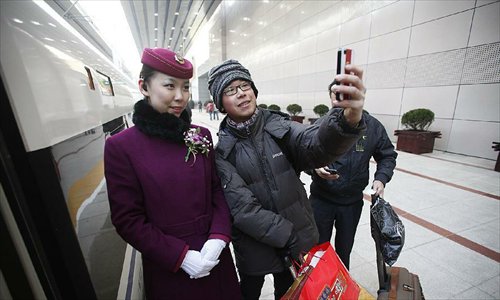
A passenger uses his mobile phone to take a group photo with a stewardess before boarding bullet train G801 to leave for Guangzhou, capital of South China's Guangdong Province, at the Beijing West Railway Station in Beijing, capital of China, December 26, 2012. The world's longest high-speed rail route linking Beijing and Guangzhou started operation on Wednesday. Running at an average speed of 300 kilometers per hour, the 2,298-kilometer new route will cut the travel time between Beijing and Guangzhou from more than 20 hours to around eight. Photo: Xinhua
A driver operates bullet train G801 to leave for Guangzhou, capital of South China's Guangdong Province, from the Beijing West Railway Station in Beijing, capital of China, December 26, 2012. The world's longest high-speed rail route linking Beijing and Guangzhou started operation on Wednesday. Running at an average speed of 300 kilometers per hour, the 2,298-kilometer new route will cut the travel time between Beijing and Guangzhou from more than 20 hours to around eight. Photo: Xinhua
The world's longest high-speed rail line, which spans over half of China, began operating Wednesday, further cementing the country's high-speed railway development ambitions.
Two trains departed from stations in Beijing and Guangzhou at 9 a.m. and 10 a.m., respectively, to mark the opening of the 2,298-kilometer line.
Running at an average speed of 300 km per hour, the new route cuts the travel time between Beijing and the southern metropolis from over 20 hours to about eight.
A total of 155 pairs of trains will run on the new line each day, and alternative schedules have been made for weekends and peak travel times, according to the Ministry of Railways (MOR).
There will still be 183 pairs of trains running daily on the old Beijing-Guangzhou line that runs parallel to the high-speed line, allaying concerns that the new line would increase passengers' travel costs.
A second-class seat on the new high-speed line costs 865 yuan (138 US dollars), while a sleeper on the old line sells for around 430 yuan.
"The opening of the Beijing-Guangzhou high-speed line shows China's high-speed railway network has started to take shape," said Zhou Li, director general of science and technology of the MOR.
With the opening of the Beijing-Guangzhou high-speed line, China now has more than 9,300 km of high-speed railway in operation.
The new line is one of four north-south lines expected to serve as the country's high-speed railway backbone, which also features four east-west lines.
According to the 12th five-year plan for railway development, by 2015, China will have around 120,000 km of railway in operation, including 18,000 km of high-speed railway and an express railway network of 40,000 km, which allows speeds of over 160 km per hour.
Preparations for a new high-speed line linking the central Chinese cities of Zhengzhou and Xuzhou are underway. The line will intersect the Beijing-Guangzhou high-speed rail line and the Beijing-Shanghai high-speed rail line, which started operations on June 30 last year.
"The rail network closely connects economic hubs like the Pan-Bohai economic zone, central China, the Yangtze River Delta economic zone and the Pearl River Delta economic zone and will greatly boost socioeconomic development in these regions," said Zhou.
Though the old Beijing-Guangzhou route accounts for just 3.14 percent of the nation's total operating railway mileage, it has carried 8 percent of the country's total railway cargo turnover and 18 percent of its passenger turnover, according to Sun Shuli, a chief engineer responsible for designing sections of the new high-speed line.
The new Beijing-Guangzhou high-speed line will not only improve transportation conditions, but also cut logistics costs, boost the comprehensive development of land resources along the route, enhance the investment environment and improve economic collaboration and the division of labor between regions, he said.





